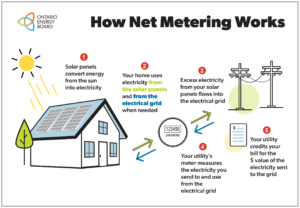
The Benefits and Mechanisms of Ontario’s Net Metering Program
In the pursuit of a sustainable energy future, Ontario’s Net Metering Program stands as a beacon of opportunity for homeowners and businesses alike. By enabling consumers to generate their own clean energy and seamlessly integrate it into the grid, this program has become a cornerstone of Ontario’s renewable energy initiatives. In this comprehensive guide of “The Benefits and Mechanisms of Ontario’s Net Metering Program”, we’ll dive deep into Ontario’s Net Metering Program, unraveling its intricacies, outlining its advantages, and guiding you through the steps to participate in this transformative energy paradigm shift.
What Is Ontario’s Net Metering Program?
Ontario’s Net Metering Program is a progressive energy policy that allows residential, commercial, and industrial customers to generate their electricity through renewable energy systems, such as solar panels, wind turbines, or small hydroelectric generators. The defining feature of this program is the ability to connect these self-generated electricity sources to the grid and receive credits for any excess power generated. Learn more on the program itself here.
How Does Net Metering Work?
Generating Electricity: Participants in the program install renewable energy systems on their property to generate electricity. Solar panels, for instance, harness sunlight to produce electricity.

Consumption and Excess Generation:
When these systems produce electricity, it is first used to power the property where they are installed. Any excess electricity generated beyond what is consumed at that moment is fed back into the grid.
Bi-Directional Metering:
A bi-directional meter is installed, which tracks both electricity consumption from the grid and excess electricity fed back into the grid. This meter records the “net” electricity usage.
Billing and Credits:
Participants are billed only for the net electricity consumed, which is the difference between the electricity they consume from the grid and the electricity they export to the grid. Any excess electricity sent to the grid results in credits on their electricity bill.
Advantages of Participating in Ontario’s Net Metering Program
Participating in Ontario’s Net Metering Program offers a host of advantages, making it an attractive option for both residential and commercial customers.
- Financial Savings
One of the most significant benefits is the potential for substantial financial savings. Participants can reduce their electricity bills by generating their electricity, and any excess electricity generated earns credits. Over time, these credits can offset or even eliminate electricity costs.
- Environmental Impact
By generating clean, renewable energy, participants reduce their carbon footprint and contribute to a more sustainable future. Solar panels, for example, produce electricity without emitting greenhouse gases, helping combat climate change.
- Energy Independence
Net metering empowers consumers to take control of their energy production and consumption, reducing reliance on traditional fossil fuels and centralized energy sources.
- Investment in Property Value
Homes and businesses with renewable energy systems often see an increase in property value, making it a wise investment in the long run.
Grid Capacity
It’s important to note that the capacity for net metering within each feeder station is not unlimited. Each feeder station has a finite capacity to handle the excess electricity generated by participants in the Net Metering Program. When this capacity is reached, no additional participants can join the program in that specific area. This limitation underscores the urgency of embracing renewable energy and the need for efficient grid management. It also highlights the importance of early participation for those considering net metering, as waiting too long means missing out on the program’s benefits in areas where capacity has already been maxed out.
Eligibility and Participation Requirements
While the benefits are clear, participation in Ontario’s Net Metering Program does come with some requirements and considerations:
- Property Ownership: Participants must own the property where the renewable energy system is installed.
- System Size: The size of the renewable energy system is subject to limits and guidelines outlined by the program.
- Connection to the Grid: The property must be connected to the local distribution grid.
- Application Process: Participants need to submit an application to their local distribution company and await approval before connecting to the grid.
Ontario’s Net Metering Program presents a remarkable opportunity for individuals and businesses to transition towards a cleaner, more sustainable energy future while enjoying substantial financial benefits. By generating clean energy, reducing carbon emissions, and gaining energy independence, participants not only contribute to a greener Ontario but also make a sound investment in their own future.
If you’re considering participation in the program, be sure to consult with your local distribution company and us, your local reputable renewable energy installer to assess your eligibility and plan your journey toward a brighter, more sustainable energy future through Ontario’s Net Metering Program.
Book your call today!

















